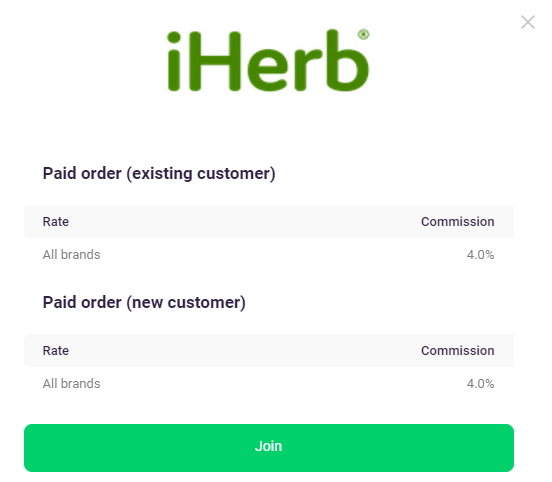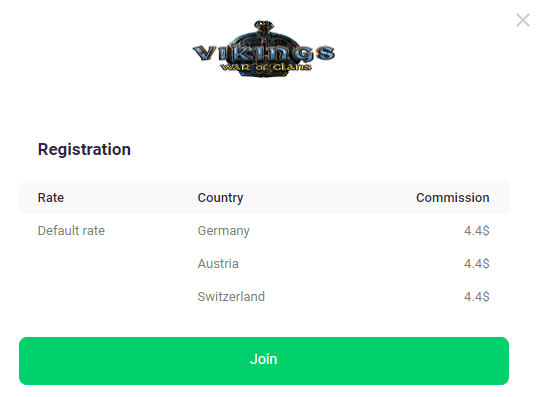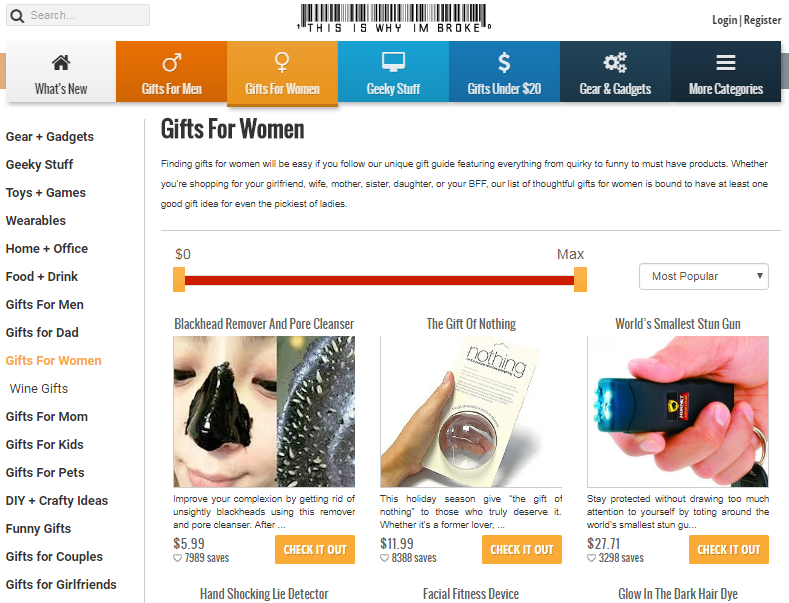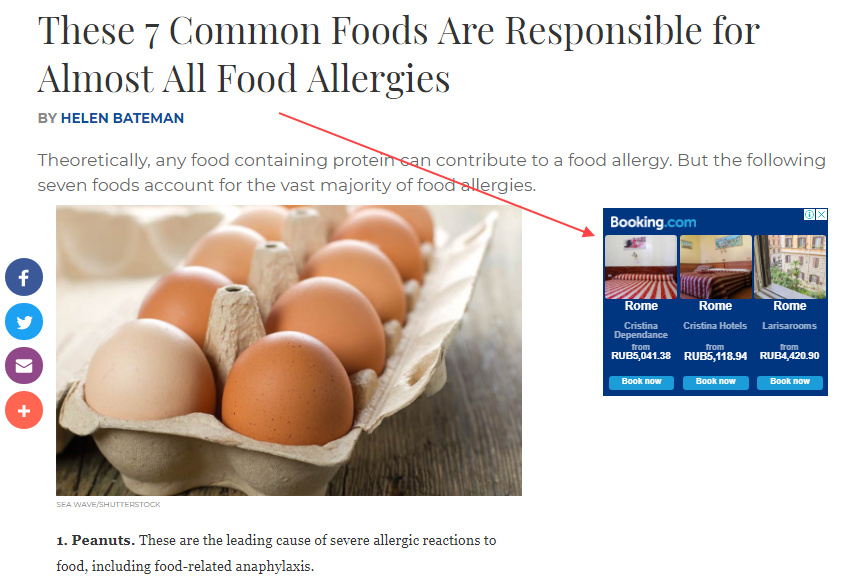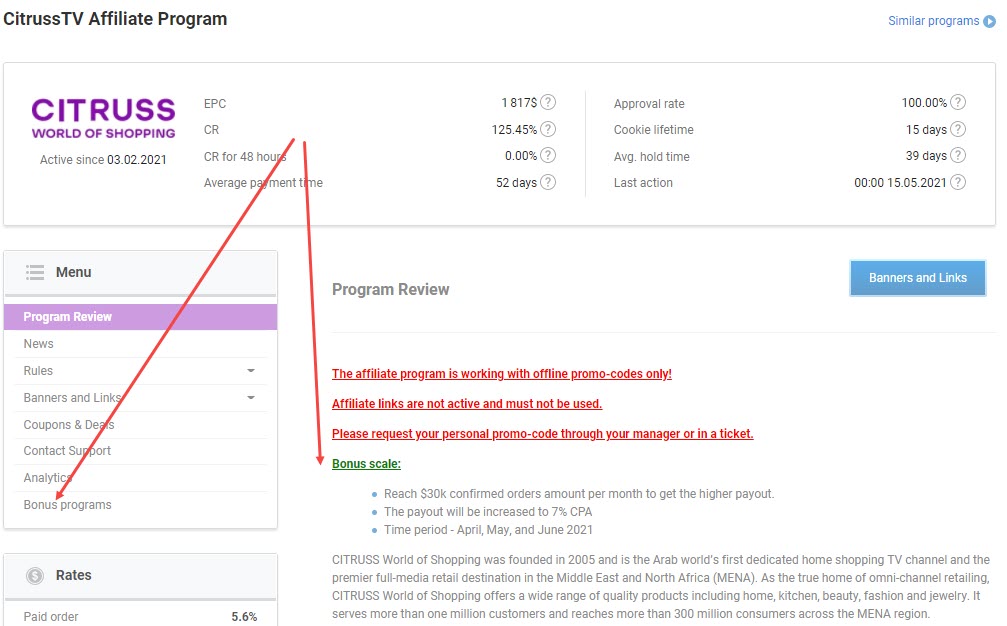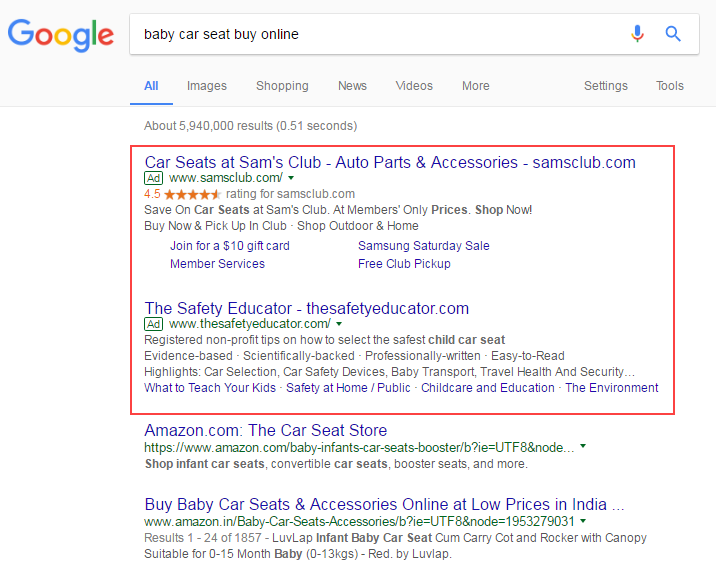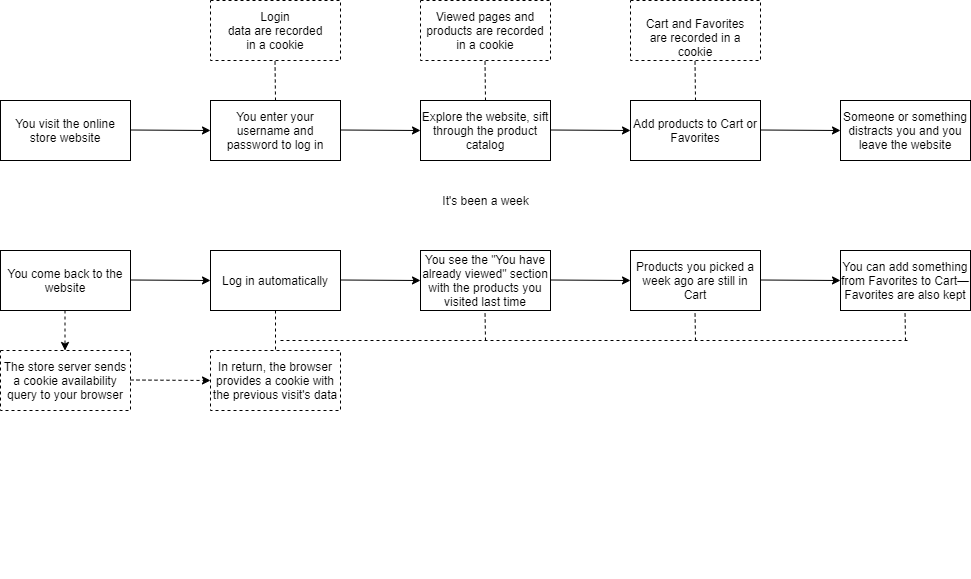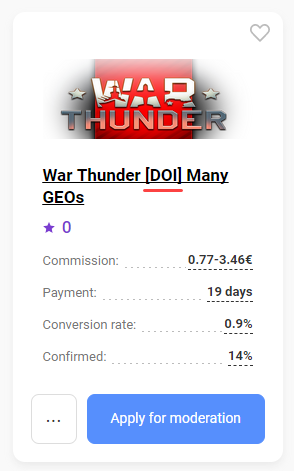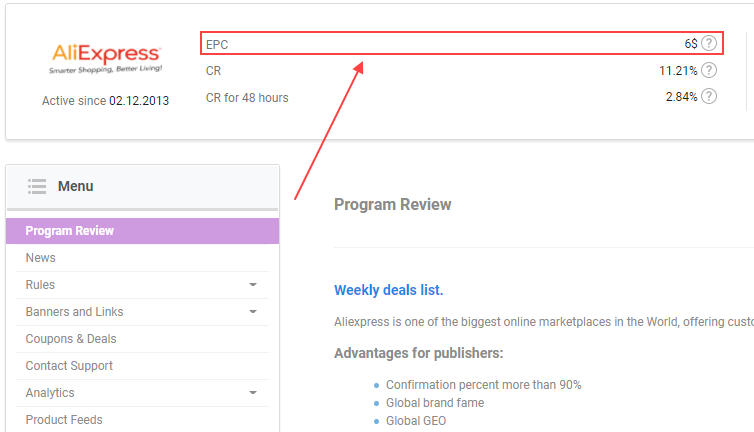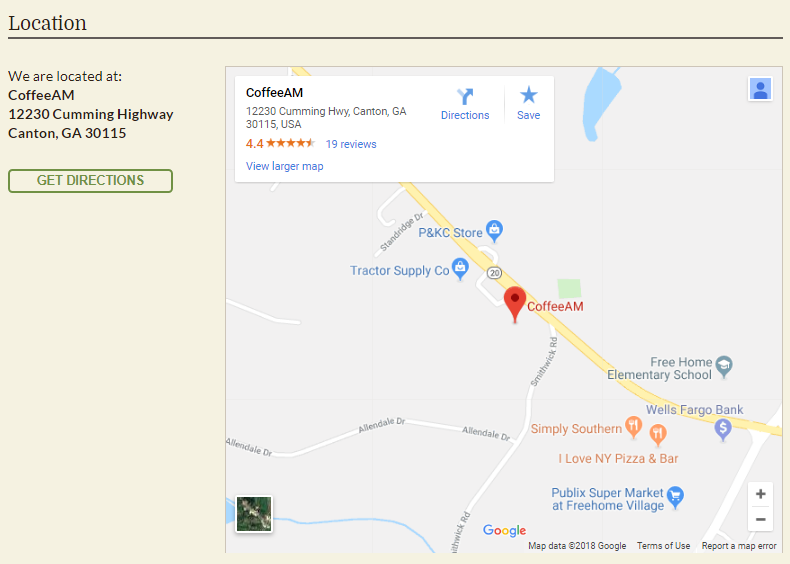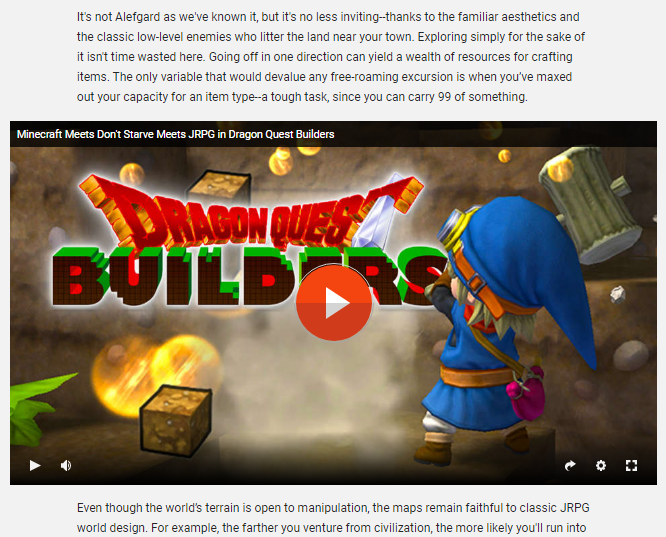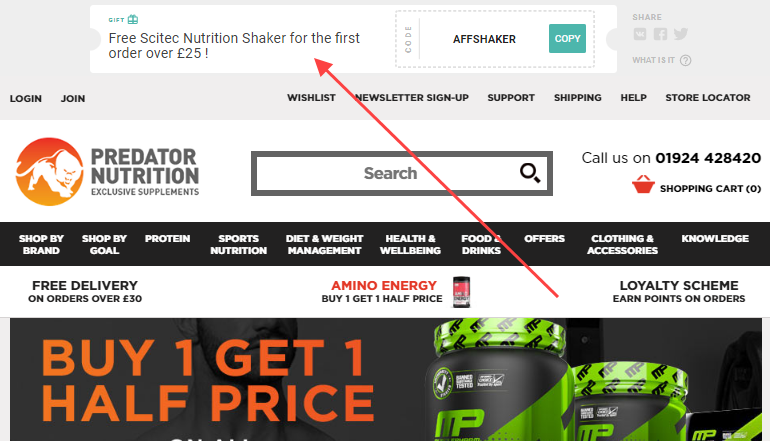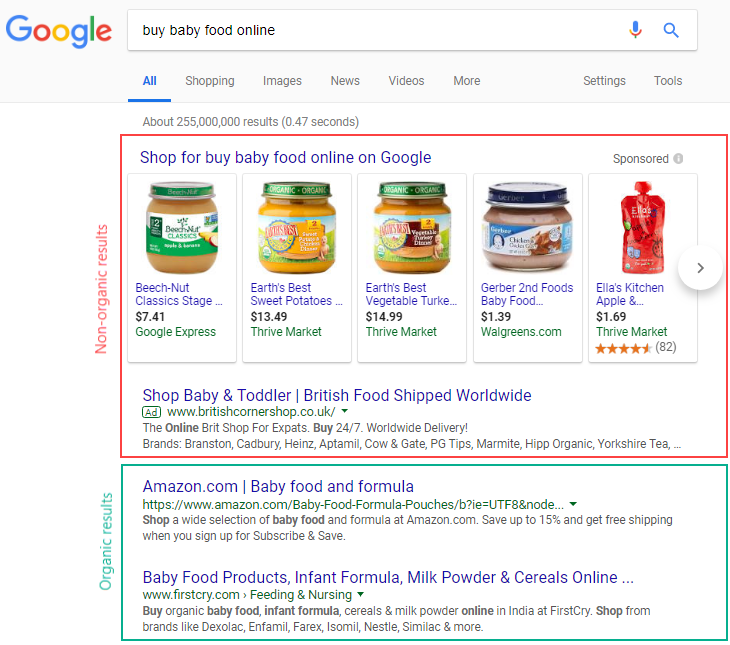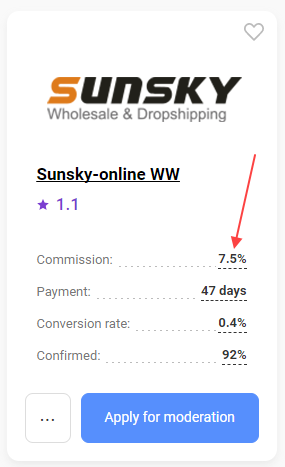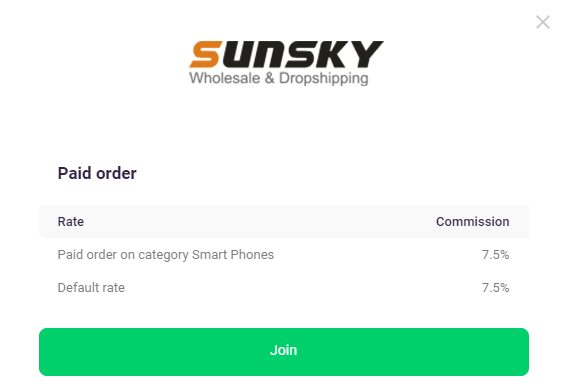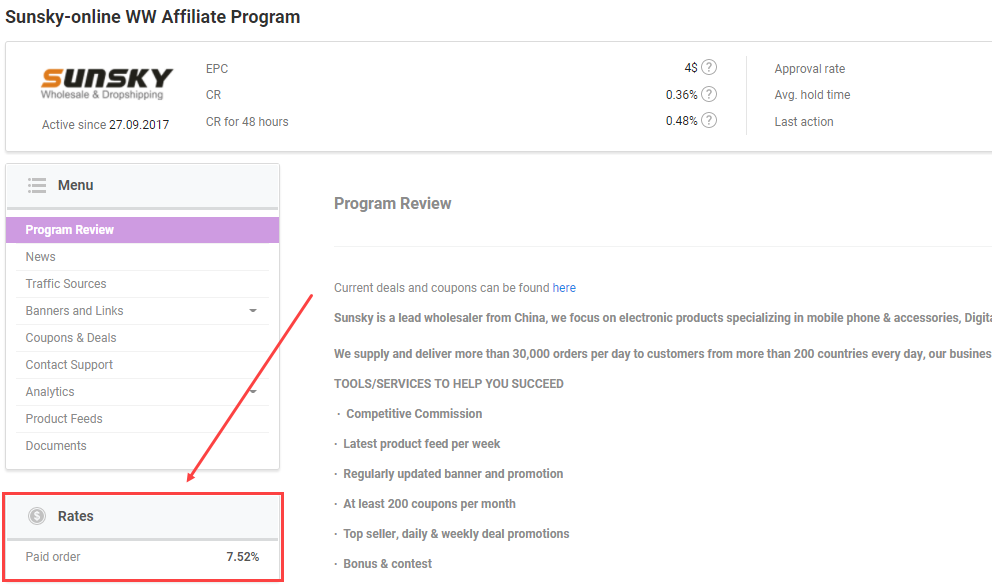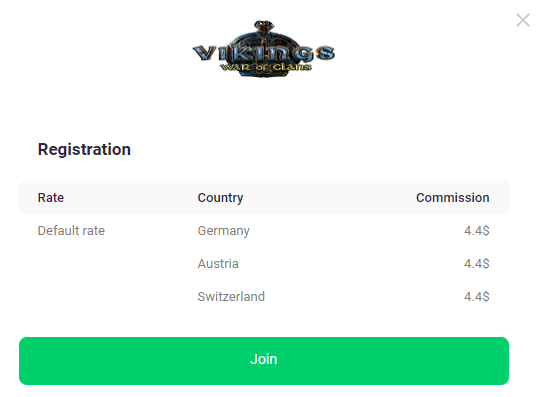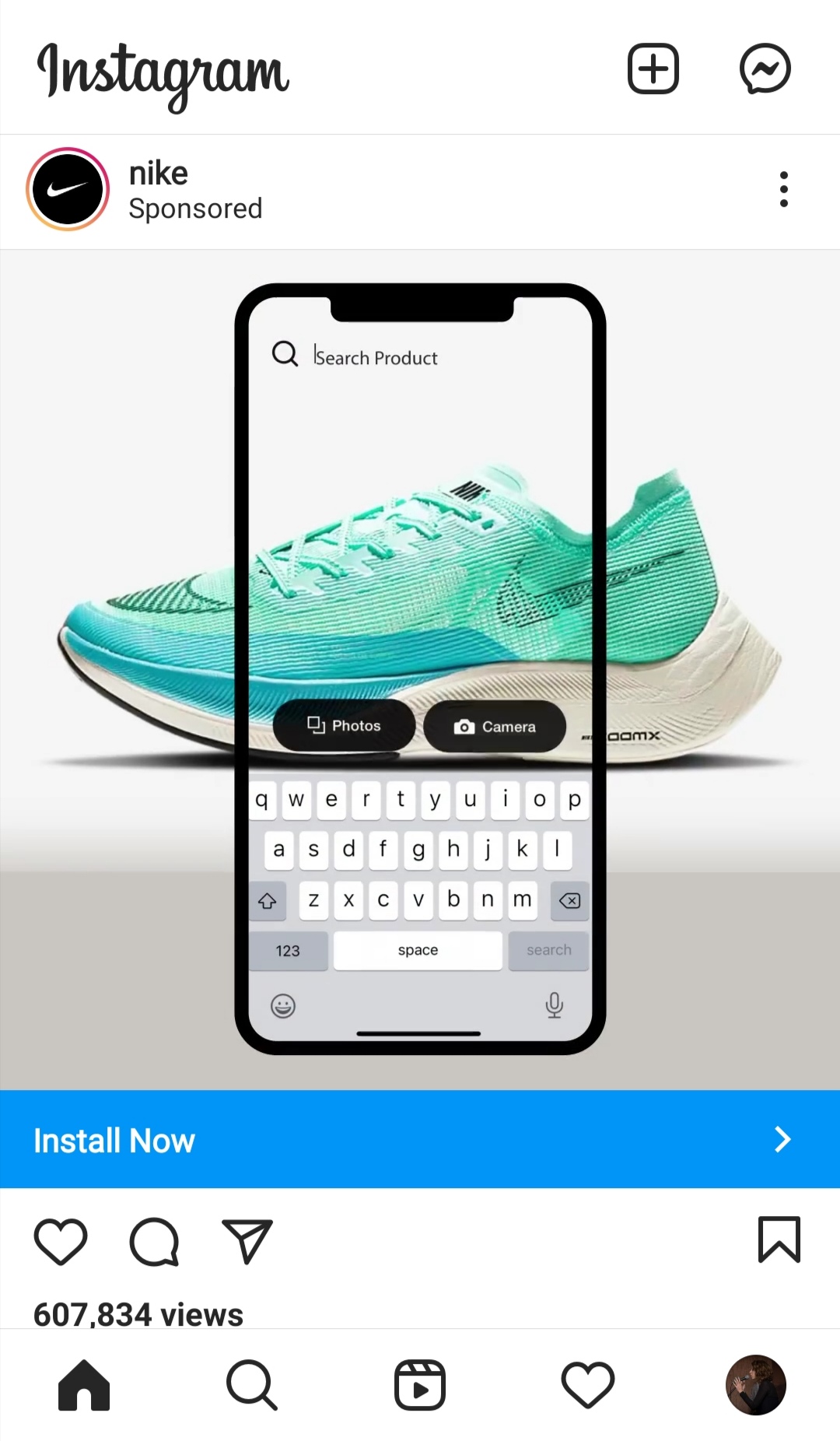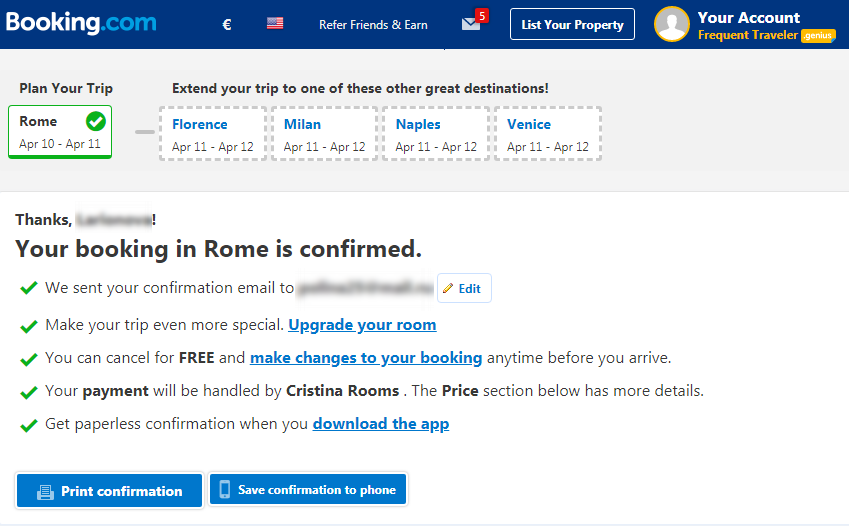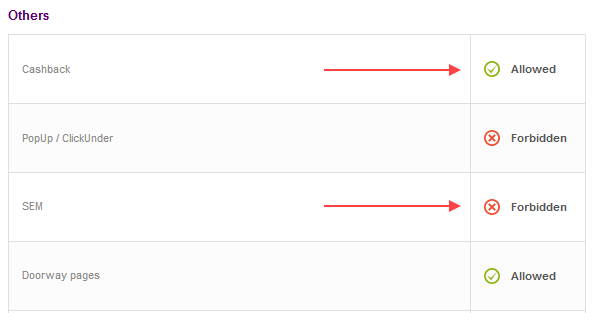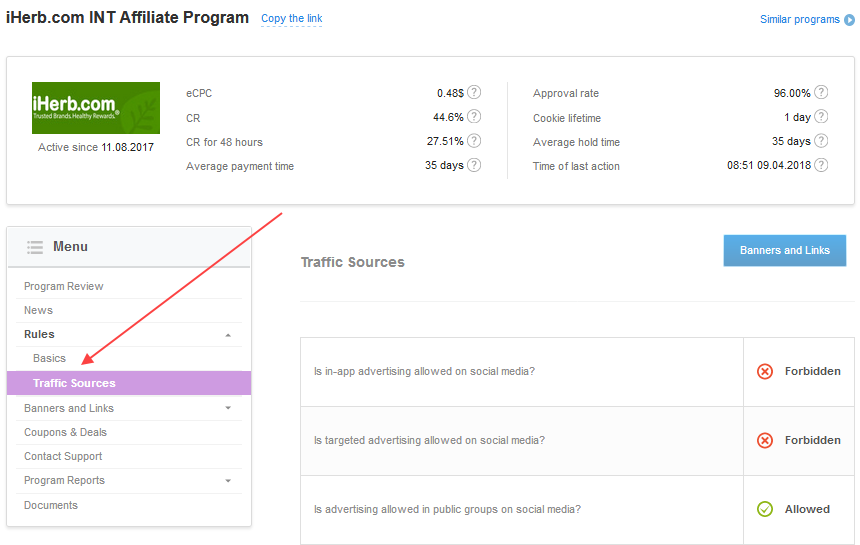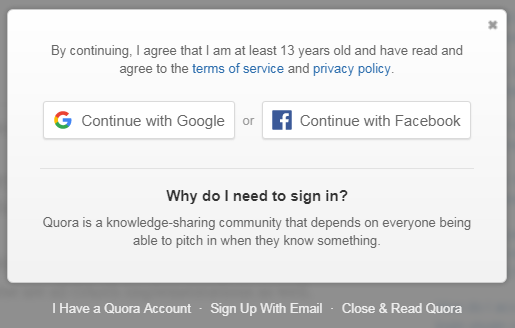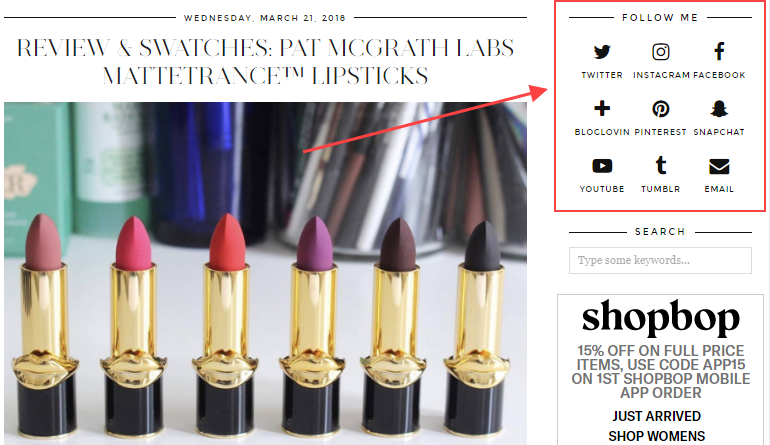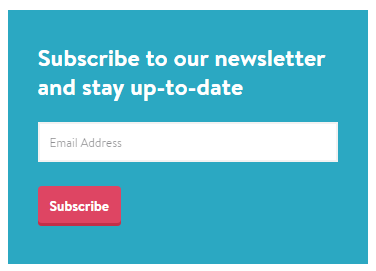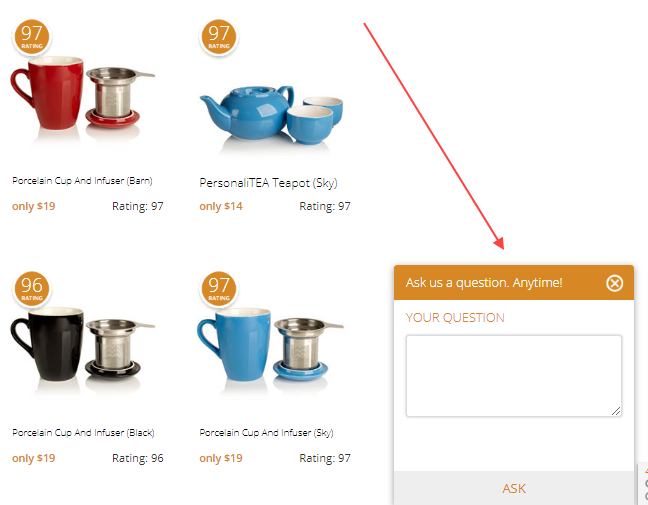-
- Account balance
- Account check
- Account level
- Action
- Ad blocker
- Ad space
- admitad_uid
- Advertiser
- Affiliate link
- Affiliate network
- Affiliate program
- Affiliate store
- API
- APK
- Approval rate
- Arbitrage
- Arbitrage system
- Attribution model
- Average hold time
- Average payment time
- Affiliate programs (Admitad Store catalog)
- Affiliate programs from partners (Admitad Store catalog)
Account balance
The term "account balance" can be applied both to a publisher account and an advertiser account.
In a publisher account, the balance is located in the Balance details section of the dashboard. It shows the reward that a publisher has earned in affiliate programs but has not withdrawn from the system yet. Read more about publisher balance in this article.
The balance of an advertiser is placed in the right corner of the account header and is calculated by the formula "the account balance minus the sum of confirmed and on hold actions". Learn more about it here.
Account check
An account check is necessary to maintain the high quality of traffic in Admitad Partner Network.
During the check, the publisher may be asked to provide detailed information on their ad space and ways they place affiliate links (targeted advertising, newsletters, product reviews, etc). The publisher may proceed with their work as usual while their account is being checked, yet they cannot withdraw funds or edit payment information.
If the account passes the check successfully, these restrictions are lifted, and it receives the AD1 account level.
In case of serious violations, the account is subject to sanctions which may vary from rejected actions to full account block. The penalty depends on the nature of the violation.
For more information on the traffic check procedure, see this article.
Account level
The account level is the publisher’s ranking in the Admitad Partner Network system. The account level is displayed in the upper right corner next to your login.
There are 4 account levels in Admitad Partner Network:
- AD0 is assigned to all publishers registered in Admitad Partner Network.
- AD1 is assigned to publishers who have earned more than $850 (or an equivalent amount in a different currency) for the whole time and passed the system check.
- AD2 is assigned to publishers who have a personal manager.
- AD3 can be assigned only to publishers that work with online games and attract good quality traffic.
Benefit of the level — AD3 publishers do not need to pass moderation when joining Online games programs.
The higher the account level is, the more opportunities a publisher has. For example, publishers with the AD2 account level can get an account manager. Most often, personal managers are appointed for big companies with high turnover.
Action
In CPA, an action is an event that a user needs to perform on an advertiser's website: to make an order, to fill out a request, to register on the website, to install an application, etc.
The two main types of actions are leads and sales.
If users perform actions, a referring publisher receives a reward from the advertiser according to a program rate.
Actions are set by advertisers depending on a goal they want to achieve. You can find the list of actions for a specific program in the program card in the Admitad Store catalog or on the program page.
For example, the goal of the iHerb.con INT affiliate program is to increase sales. Thus, its action is a paid order for which the publishers will receive 4% of the order amount.
The advertiser of the Vikings: War of Clans program wants more users to register in the game. Therefore, the program's target action is the registration of a player for which the advertiser pays $4.40.
Ad blocker
Ad blocker is a browser extension or a separate program that blocks ad content (banners, videos, pop-ups, click-unders, etc.) on the web page. The most popular example of such a program is AdBlock.
A few figures
According to the PageFair 2017 Global Adblock Report, in December 2016 there were over 615 million desktop and mobile devices running ad blocking software globally. In the US, about 18% of users use this software, in India and Germany, for example, the proportion is 28% and 29% respectively, and in Indonesia, ad blockers are used by every second user (58%). The proportion also depends on the website category and audience: ad blockers are more popular among players than subscribers of fashion blogs and men are more likely to use ad blocking software than women.
Impact on publishers
From publishers' point of view, users with installed ad blockers can be considered as wasted traffic, as they do not see the publishers' ads. Accordingly, the higher is the proportion of such users, the less are the earnings of publishers. Another problem is blocking tracking codes on thank you pages on advertisers' websites. In this case actions of users who use ad blockers are not fixed in the statistics, so publishers do not get rewards for them.
Ways of solving the problem
For publishers who work with banners and pop-ups, i.e. elements that are blocked by most ad blockers, a possible solution is switching to less annoying ad formats to get their ads whitelisted.
If you drive traffic through your own website, try to politely persuade your visitors to disable ad blockers, let's say, on the pretext of incorrect website operation. However, do not try to force users by hiding website content or using any other aggressive methods of "persuasion". It will only irritate the visitors and cause audience outflow.
When you place ads, do not insert standard affiliate links, use deeplinks. Firstly, it is more convenient, as these links can lead to any page of an advertiser's website, not just to the main page. And secondly, usually, they are not blocked by AdBlock or similar software.
As for the advertisers who select integration via tracking code, we strongly do not recommend placing it in the Google Tag Manager (GTM), as it is included in the list of blocked elements. If a program has already been integrated with tracking code in GTM, here are the ways to fix the problem:
- remove the code from GTM and place it in another part of the page;
- switch to another type of integration: Postback, XML, API;
- add GTM as an exception to EasyPrivacyList;
- use an alternative solution SegmentStream.
To learn more about these options contact specialists of the Admitad Partner Network Tracking Department.
Ad space
Ad spaces are online resources where publishers promote advertisers' products or services.
For example, a website where its owner places banners or ads can be considered an ad space. Another option is a YouTube channel where a video blogger posts videos and links to products in the video descriptions.
The Admitad Partner Network publishers are encouraged to use the following resources as ad spaces:
- Social media channels, such as Facebook, Instagram, YouTube, etc.
- Instant messengers, such as Telegram, Viber, WhatsApp, etc.
- Websites, including any content-based websites, forums, landing pages, e-commerce storefronts, etc.
- Web services, including loyalty programs, cashback services, coupon services, email newsletters, etc.
- Traffic arbitrage (traffic purchasing and reselling) using Google Ads, Facebook, Instagram, etc.
- Programs and apps, including browser extensions, mobile apps, etc.
For more information about ad spaces, visit these guides:
- Publisher's ad space: the basics
- What can serve as an ad space?
- The types of traffic used in the Admitad Partner Network
admitad_uid
admitad_uid is a unique click identifier, which is contained in all affiliate links. When a user clicks a publisher's affiliate link and goes to the advertiser's website, a cookie with admitad_uid value is recorded in their browser. When the user performs an action and goes to the thank you page, the advertiser system checks if the user's browser has admitad_uid. If it is there, the system recognizes that the action belongs to the affiliate program, and sends the data about it to Admitad. The Admitad Partner Network system via admitad_uid identifies which of the publishers attracted this user and attributes this action to them.
If admitad_uid is lost at some stage, the action cannot be tracked. Therefore, it is important that publishers attract traffic only through affiliate links, not regular links (as they do not contain admitad_uid), and advertisers process admitad_uid on all pages of their websites and correctly pass it to the Admitad Partner Network side.
Advertiser
Advertiser is a company that wants to promote its products and services online and launches an affiliate program.
Affiliate link
An affiliate link is a link that leads to to the website of an affiliate program. The affiliate link contains an identifier, unique for each publisher so that the system could determine what publisher brought the user to the advertiser's website.
The affiliate link is provided by an advertiser. The publisher places it on their ad space and if some users follow this link and perform target actions on the advertiser's website, the publisher will get a reward. When a user follows the link, their browser records a cookie, so even if the user performs a target action in a month after they followed the affiliate link, in case the cookie is still valid, this action will be assigned to the publisher. If during the cookie lifetime the user performs several target actions, all of them will be also assigned to the publisher (in case it does not contradict the terms of the program).
Standard affiliate links lead to the main page of the program website, which is not always convenient. To generate affiliate links to a particular product page or product category, use Admitad Partner Network's special tool called Deeplink.
It is important not to change the affiliate link arbitrarily in order to save all parameters in the link. For example, if you lose admitad_uid (the unique identifier we mentioned above), clicks and actions for your link will not be tracked by the system, so you will not receive the reward for them.
Affiliate network
An affiliate network is an intermediary between publishers and advertisers.
The larger the advertisers, the more publishers they work with. Cooperation with each publisher requires certain time and labor costs (for signing a contract, integration, processing payments), and some advertisers cannot afford such costs. In this case, they hire an intermediary, i.e. affiliate network, that provides the following services:
- placing the advertiser's affiliate program on their website;
- organization of tracking system;
- keeping statistics;
- technical support for publishers and advertisers;
- consulting publishers;
- control over compliance with the rules by publishers, banning rule-breakers;
- making payments to publishers.
For performing these functions an affiliate network gets the commission.
If an advertiser and a publisher have disagreements, an affiliate network acts as an independent arbitrator.
Affiliate program
An affiliate program is a form of business cooperation between an advertiser and a publisher where the publisher takes part in an ad program and the advertiser pays the publisher a reward.
Advertisers are companies that own e-stores, banks, travel agencies, and other establishments that advertise their products or services on the Internet.
Publishers are users with an active presence on the Internet who post notifications or ads, as well as owners of web resources, communities in social networks, and online applications or games. In short, they are users who are able to send traffic to the advertiser's site.
A reward may be paid as a percentage of the sales or as a fixed amount per target action performed by a client who was brought by the publisher.
At the start of the affiliate program, the advertiser usually indicates the terms of ad placement, the payment method for the affiliate reward, the cookie lifetime), the requirements to traffic quality and its sources, and also provides creatives and access to various additional resources. For example, the advertiser can share the XML feed for its products or permit publishers who use retargeting to place a code on the pages of its website using the ReTag tool.
Affiliate store
An affiliate store is a website that earns money by linking products from its website to the advertiser's website. Such websites usually look like an ordinary online store: there is a product catalog with product photos, descriptions, prices, sometimes the "Add to cart" or "Buy" buttons. The main difference is that affiliate stores do not sell goods; their main goal is to redirect users to the advertiser's website where the product is actually sold. So, after users click on a photo or the "Buy" button, they are redirected to the product page on the advertiser's website. If they make a purchase there, the owner of the affiliate store gets a reward.
Here is an example of an Amazon affiliate store. I.e. when you click on "Check it out" you are redirected to the relevant product page on amazon.com.
Sometimes affiliate stores act as intermediaries between the buyer and the online store. In this case, buyers are not redirected anywhere, they really add products to the cart and complete the order. After that, the owner of the affiliate store collects the orders and places one large order on the advertiser's website. This business model is called dropshipping.
API
API (Application Programming Interface) is an interface that provides interaction between applications. This is a ready-made code designed to perform a specific function. With an API, the developer does not need to write code from scratch but can use ready-made solutions, which makes the process easier and faster.
The API is used to get access to the functionality and database of a third-party program. For example, with its help you can:
- implement authorization on the website or in the application through a Facebook or Google account;
- add Google Maps to the website;
- place YouTube videos on the website;
- accept payments through WebMoney, PayPal, bank cards;
- receive Google Ads statistics;
- translate website content, etc.
APIs are created by the developers of the program or application to make their products available to a wide audience. Accordingly, you can find the API of the required program on its website, usually in the For developers or Documentation section.
Admitad Partner Network also has an API for advertisers and publishers. You can find it here. Its capabilities almost completely duplicate the functionality of the personal account on the website. Thus, you have great opportunities to automate the workflow.
Using the Admitad API, a publisher can:
- receive a list of programs which their ad space is joined;
- work with coupons and banners;
- generate deeplinks and test links;
- download reports;
- work with API traffic.
For advertisers, the following functionality is available:
- obtaining information necessary for program integration through API;
- downloading of different types of reports;
- downloading a list of ad spaces joined to the program.
APK
If you see the abbreviation "APK" (Android Package Kit) in the name of a mobile program, it means that the advertiser's Android app is downloaded not from Google Play, but from another source.
Approval rate
The approval rate is the ratio of the confirmed target actions to the total number of confirmed and declined actions.
The indicator is shown in the affiliate program card and on the affiliate program page.
Formula:
Period: period from Date1 to Date2, where
- Date2 = TodayDate minus 30 days
- Date1 = Date2 minus 360 days
Example
Today is December 23, 2020. The indicator will be calculated for the period from November 29, 2019 to November 23, 2020.
Confirmed actions is the number of actions with the statuses Confirmed and Confirmed, awaiting advertiser payment for the specified period in the program.Declined actions is the number of actions with the status Declined for the specified period in the program.
Refresh interval: daily.
As you can see, the approval rate is calculated with a 30-day delay. Therefore, if the advertiser declined a high number of actions for the previous months but the situation has gotten better recently, the indicator will remain low for some time. It will rise after this 30-day "lag period".
Arbitrage
Traffic arbitrage means buying traffic (attracting users) and selling it (redirecting users) at a better price. The most popular traffic sources are teaser and banner networks, social networks, and contextual advertising. If you want to work with traffic arbitrage, it is important to choose an affiliate program and an ad space so that the conversion rate will be high.
E.g. you work with a program that pays 10$ for registration. You placed an ad in Google Ads and set 50 cents for a click. 10 users clicked on your ad and came to the advertiser's website, i.e. you bought traffic for 5$ and sold it to the advertiser. If at least one of the 10 users gets interested and registers on the website, you will get 10$. This way if you have 10% CR, your revenue will be 5$, However, if there will be 20+ clicks but no conversions, you will bear losses.
Arbitrage system
An arbitration system is a web platform, where an arbitrator can attract traffic for further redirection. Banner and teaser networks, contextual ads, and other platforms that allow a publisher to buy traffic from websites can act as an arbitrage system.
Attribution model
An attribution model is a method of defining the contribution of each traffic source to the conversion. The attribution model helps to understand which traffic sources perform better and which ones need to be invested more actively to make the ads more efficient.
In affiliate networks, the attribution model determines which of the publishers should be given all the credit for a user's action and, accordingly, get the reward for it.
At the moment the most popular attribution models are :
- Last Paid Click or Last Cookie Wins — the action is attributed to the publisher whose link was the last one the user clicked before the action was committed. Admitad Partner Network operates just by this attribution model.
- First Click — all the credit for the conversion is given to the very first traffic source.
- Funnel Based — the action is assigned to all publishers whose links the user clicked before performing the action. In this case, the advertisers themselves distribute the credit between all traffic sources in the chain. For example, the first source gets 30% of the credit, the second one gets 15%, and the third one receives the remaining 55%. Then the first publisher receives 30% of the reward amount, the second publisher is paid 15%, and the last one gets 55%. Often, remuneration is distributed equally among all participants on the chain.
Example
The user watched a game review on YouTube, and he liked the game so much that he clicked an affiliate link under the video and got to the store's website. At that moment, something stopped him from buying it, and he closed the page. A few days passed, and he came across another review on the game in a Facebook community, followed the link again, and even added it to the cart, but then remembered that is running out of money and decided to wait. And here, on the day he got paid he saw a banner with this game at IGN, decided that it is fate and finally bought the game.
According to the First Paid Click model, the action and reward will be attributed to the vlogger, by the Last Paid Click model they will be assigned to the publisher who placed the banner, and by the Funnel Based model, all participants, including the author of the Facebook review, will receive rewards.
These models are the most common, but not the only ones. For each ad campaign, it is better to select its own attribution model based on the users' behavior in order to collect data that reflect the reality as much as possible. For example, Google Ads in addition to the above-mentioned models also uses the "Data-driven", "Position-based" and "Time decay", their description can be found here.
Average hold time
The average hold time is the average time during which the advertiser confirms or declines the action.
This indicator is shown on the affiliate program page.
Formula:
Period: period from Date1 to Date2, where
- Date2 = TodayDate minus 30 days
- Date1 = Date2 minus 120 days
Example
Today is December 23, 2020. The indicator will be calculated for the period from July 26, 2020 to November 23, 2020.
Total processing time is the total time spent on processing all actions of all publishers in the program.
Processing time is the period during which the action remains in the status On hold—i.e., from the moment of the action creation to the moment when it receives the status Confirmed, Confirmed, awaiting advertiser payment, or Declined.Processed actions are all target actions in the program that the advertiser confirmed or declined during a certain period.
Refresh interval: daily.
Average payment time
The average payment time is the average time during which the advertiser confirms or declines the action.
This indicator is shown on the affiliate program page.
Formula:
Period: period from Date1 to Date2, where
- Date2 = TodayDate minus 30 days
- Date1 = Date2 minus 120 days
Example
Today is December 23, 2020. The indicator will be calculated for the period from July 26, 2020 to November 23, 2020.
Total payment time is the total time spent on paying for all actions of all publishers in the program.
Payment time is the period from the action creation moment to the moment when the reward for the action is credited to the publisher balance.Processed actions are all target actions in the program that the advertiser confirmed or declined during a certain period.
Refresh interval: daily.
Affiliate programs (Admitad Store catalog)
Type of affiliate programs in which actions are tracked via affiliate links. Such programs are fit for site owners, cashback services, coupon sites, etc. The full list of available programs can be found in the Admitad Store catalog.
Affiliate programs from partners (Admitad Store catalog)
Type of affiliate programs, actions in which are tracked via affiliate links provided by our partner services. Programs of this type have huge variety and are easy to integrate. As all affiliate programs, they are designed for owners of sites, cashback services, coupon sites, and other web resources. The full list of available programs can be found in the Admitad Store catalog.
-
Banner
A banner is an advertising image that contains a link to an advertiser's site. Banner advertising is the most common type of online advertising.
By format, the banners are divided into:
- Static (JPEG);
- Animated (GIF, Flash);
- Text (Richtext);
- Interactive (JavaScript, Flash).
Pros of banners:
- A publisher does not need to make any special effort, just to place a banner on their ad space;
- Great audience coverage;
- Effective well if the goal is to increase brand awareness.
Cons of banners:
- Low CTR and CR (can be increased by setting retargeting);
- Banner blindness;
- Can be blocked by special extensions like AdBlock.
Depending on the purposes and model of Internet advertising, the effectiveness of the banner is estimated by the number of impressions, the number of clicks and CTR, or the number of target actions (CR).
Banner blindness
Banner blindness is a phenomenon when a user deliberately or unconsciously ignores banners or banner-like objects. The reason is a huge flow of information that users face every day. To avoid information overload, they focus on finding the specific information and do not pay attention to all unnecessary, especially bright moving elements like banners and videos. Banner blindness is one of the main disadvantages of banner advertising.
Behavioral targeting
Behavioral targeting is a technique that allows to show users only ads that match their interests. Behavioral targeting is considered one of the most promising types of targeting. This technique is used by Google when displaying ads on the Google Display Network (GDN). Also used when setting targeted ads in social networks.
The concept of user interests varies depending on the platform on which the ad is placed. So, in GDN the ads are shown based on the user's search queries on the GDN sites and YouTube. If you add a targeted ad on Facebook, the interests will include the communities to which a user is subscribed, the apps that he plays, the pages he liked. The data about the interests are collected with the help of cookies.
Thanks to behavioral targeting, it became possible to place on websites not only those ads whose themes are relevant to the site themes, but also any other ads, and still find the target audience for them. Thus, target audience coverage and the number of clicks on the ad increase.
An example of behavioral targeting
If a user booked a hotel at Booking.com, some time after that she will see its ads on other websites, even if their theme does not match the advertised product.
Bonus
Bonus is an extra reward that an advertiser accrues to a publisher for fulfilling the terms of a bonus program or winning in the contest.
To learn if an advertiser has a bonus program, go to the menu on the program page. Often the bonus program terms are specified in the description.
The decision on paying bonuses is taken after processing all actions for the month. It means that if an advertiser processed the last July actions in September, and it turned out that a publisher had fulfilled the terms of the bonus program, he would receive a bonus for July in September.
Brand bidding
Brand bidding is a kind of contextual advertising when keywords of the advertisement contain the name of an advertiser's brand. Usually, brand bidding is forbidden by advertisers.
Example
If you work with "Asos" affiliate program that bans brand bidding, then when creating an advertisement, you can not add the word "Asos", its transliteration and derivatives to the keywords.
Why is brand bidding usually prohibited by advertisers?
If advertisers place contextual ads themselves, each ad that contains their brand name but does not belong to them deprives them of a part of the audience and traffic. Moreover, search engines show only ads with the highest costs per click, so the advertisers have to constantly compete with publishers and raise CPC, which leads to higher costs. And if a user clicks on a publisher's ad and performs an action there, the advertiser will also have to pay a reward to this publisher.
Example
Advertiser "Babyshop" that works with publishers and places its own ads (i.e. spends certain funds on them). If brand bidding is prohibited, for all search requests such as "babyshop", "babyshop dresses", "babyshop toys" in the search results will be shown only Babyshop's ads. If it allows brand bidding, the search results will include not only its ads, but also publishers' ads. It may even turn out that Babyshop's ads will not be shown at all, and users will click on someone else's ads. This way though "Babyshop" spends money on placing its ads, it will not get results from it and what's more, it will have to pay publishers for all actions performed on their ads.
Even if the advertisers do not place ads themselves, brand bidding is still unprofitable for them: as a rule, the advertiser's site is the first on the search engine results page (as the advertisers also spend a lot of labor costs for SEO), and most users will click on it. If brand bidding is allowed, the first result will be not the advertiser's site, but the publisher's ad.Note that this restriction applies only to contextual advertising, i.e. if your ad space is a community in a social network or a YouTube channel, you can freely use the word "Babyshop" without any trouble (if these traffic sources are allowed by the affiliate program).
Besides, the ban on brand bidding does not mean a ban on the use of all brand names, but only on the use of the advertiser's brand name.
Example
Babyshop sells goods of various brands (Esprit, Garcia, etc.). So, if you place a contextual ad, you cannot use "Babyshop", but "Esprit", "Garcia" are allowed.
In Admitad Partner Network most affiliate programs ban this type of traffic, but there are affiliate programs where brand bidding is allowed. You can learn it from program rules.
Branding
Branding is a form of internet advertising when a webpage or several webpages of a website are designed in the style of a promoted product. Usually it includes changing the background and the upper part of the site, using brand colors and logos, product images, and integrating links to an advertiser's website.
Pros of branding:
- unobtrusive;
- large audience coverage (all visitors of the website or the webpage);
- improves product awareness and loyalty to it;
- cannot be blocked or turned off.
-
- 48-hour conversion rate
- Click-under
- CMS
- Contextual advertising
- Conversion
- Cookie
- Cookie lifetime
- CPA
- CPC
- CPI
- CPL
- CPM
- CPP
- CPS
- CPV
- CR
- CTR
- Creative
48-hour conversion rate
CR (Conversion Rate), 48-hour conversion rate is the ratio of the number of target actions to the total number of affiliate link clicks for the previous and current day.
This indicator is shown on the affiliate program page.
Formula:
Period: period from Date1 to Date2, where- Date1 = TodayDate minus 1 day
- Date2 = 4:50 AM TodayDate.
Example
Today is November 10.
The indicator will be calculated for the period from 12 AM November 9 to 4:50 AM November 10.
Target actions is the number of confirmed and not yet processed target actions in the program for the specified period. The following actions are taken into account:- On hold
- Confirmed
- Confirmed, awaiting advertiser payment
Clicks is the number of transitions to the advertiser website through the affiliate links of all publishers in the program, for the same period.
Refresh interval: daily.
If the program registered a small number of actions, this indicator will have different values on different days.
Click-under
Click-under is an ad type similar to pop-up and pop-under. Here's how click-unders work: a user visits the website, clicks on any place, and the advertiser website opens in a new window. Sometimes, a landing page opens first, from which the user can go to the advertiser website.
Advantages & benefits:
- Unlike pop-ups, click-unders open in the background and don't mess up the user's experience. with the page they are exploring—thus, click-unders are less irritating.
- Cheap traffic.
- Wide audience reach.
- Simple setup.
Downsides:
- Most users do not trust popups.
- The reverse side of wide reach is that you get a cold audience—i.e., not interested users that accidentally landed on the promoted resources and are not likely to convert into buyers.
- AdBlock and other advertisement arresters can block it.
- May negatively affect the website's SEO.
CMS
CMS (or WCMS – Web Content Management System) is a software solution for creating, editing, and managing Web pages and their content. It was developed to speed up and simplify the work of website owners, especially those who are not familiar with programming.
Sometimes working with CMS means populating existing templates of e-stores, blogs, or personal websites with your content. The user has simple visual editing tools that do not require the use of markup language and is able to preview the final result before uploading the data to the server. CMS is also used for editing database content, that is, replacing or editing text and graphics without changing the website design.
Contextual advertising
Contextual advertising is a type of Internet advertising when advertisements (banners, videos, or texts) are displayed according to keywords in a user's query.
Features of contextual advertising:
- An advertisement is shown only to potentially interested users.
- An advertisement is paid by CPC model, and it is a publisher who sets the cost per click;
- To determine which of the advertisements to show on the page, the system every time runs an auction, compares costs per click for all advertisements, and selects the advertisements with the highest cost. Another important parameter is CTR: if costs per click of advertisements are the same, the advertisement with higher CTR will be shown.
Contextual advertising can be divided into contextual advertisements in search engines and on websites.
Contextual advertisements in search engines
Advertisements that are shown on the search results page of search engines like Google or Yahoo. Advertisements are placed above, below, and sometimes to the right of the search results. The principle of the ad selection is the following: when creating an ad, a publisher specifies keywords; if these keywords suit keywords in a user's query and the ad wins an auction, it appears on the search results page.
Contextual ads in Google
Contextual advertisements on websitesAdvertisements that are shown on the websites that are part of the ad networks like Google Display network. As there is no search query, the system selects those ads whose keywords suit the topic of a website or the user's previous queries.
Conversion
An event that occurs when a visitor click-throughs a link and makes a purchase from or generates a lead for an advertiser. Publishers earn commissions when conversions occur.
Cookie
A cookie is a text fragment with user information that was collected during their visit to the website. A cookie is sent from the website server and stored in the user browser. When this user visits the website again, the website server will request cookie data from the browser to restore user information.
Cookie use case
It is cookie lifetime that defines how long data will be stored. Once the lifetime expires, the cookie is deleted from the browser.
Let's assume that in the above example, a cookie lives 30 days. If the user doesn't place an order within this period, a cookie with Cart data will be erased and they will have to assemble their order again.In Admitad Partner Network, cookies are mainly used to track target actions users perform on advertiser website and assign them to publishers (see admitad_uid). Besides, cookie stores settings and preferences of publishers and advertisers (e.g., account language).
Read our Privacy Policy to learn more about what cookies Admitad Partner Network uses and what for.
Cookie lifetime
There are per-session cookies, which are deleted after the session, and persistent cookies, which are deleted after a set validity period. Persistent cookies are used in CPA marketing to store a user's association with the publisher, even if the user does not perform the target action during the first visit to the advertiser’s website.
The cookie lifetime is the validity period during which a cookie received by the user's browser and associating it with a specific publisher is stored in the user's computer. If the user performs a target action during this period, this action will be considered a user brought by the publisher even if a person had closed the browser or turned off the computer.
A repeated target action performed by the user during the cookie lifetime will also be credited to the publisher unless otherwise specified in the affiliate program description.
At the end of the cookie lifetime, it is automatically deleted by the browser and the user's actions will no longer be associated with the publisher until the user clicks that publisher's affiliate link again.
In Admitad Partner Network, the cookie lifetime is specified in the description of any program. This value is also called a PostClick cookie. Obviously, publishers prefer programs with longer cookie lifetimes because this increases the chance of users performing target actions. For example, after thinking about it, they may decide to make a purchase at the advertised e-store.
CPA
CPA (Cost Per Action) is an online advertising pricing model when an advertiser pays a publisher for every action performed by a user that was brought to the advertiser's website by the publisher.
Features of CPA advertising:
- An advertiser pays not for impressions or clicks, but for leads and orders, i.e. for those actions that bring real results.
- The conversion rate is higher than in CPM or CPC advertising.
- Cost per action is higher than cost per click or cost per impression.
CPA can be divided into CPS and CPL.
CPC
CPC (Cost Per Click) is an Internet advertising model in which an advertiser pays a publisher when a user clicks on a banner or link placed by the publisher.
Model features:
- cost per click is usually higher than cost per impression but lower than cost per lead or cost per sale
- works perfectly if your goal is to boost traffic website
CPI
CPI (Cost Per Install) is an online advertising pricing model in which an advertiser pays a publisher reward if a user attracted by the publisher has installed the advertiser's app. The model is typical for mobile programs.
CPL
CPL (Cost Per Lead) is an Internet advertising model in which an advertiser pays a publisher for a lead. A lead is an explicit sign-up from a consumer interested in the advertiser's offer, a filled-out form, a registration for a webinar or course, etc.
CPM
CPM (Cost Per Thousand, Cost Per Mille) is an Internet advertising model in which an advertiser pays a publisher for every 1,000 impressions of an ad (usually, banner).
Model features:
- works great if the goal is brand awareness
- wide audience reach: the user doesn't have to do anything to view an ad: it's shown automatically
- cost per impression is lower than cost per click, lead, or sale
- no guarantee that the user will click on the ad after they see it
- can be blocked by AdBlock or similar programs; can be ignored by users due to banner blindness
CPP
CPP or Cost Per Player is an online advertising pricing model when an advertiser pays a publisher for an active registration of a user in the advertiser's online game. An active registration can mean passing a tutorial, achieving level 1, or other actions that are more complicated than an ordinary registration but still do not require much effort from a user.
CPS
CPS (Cost Per Sale) is an Internet advertising model in which an advertiser pays a publisher when a product is service is bought by a user the publisher led to the advertiser website. If the order was canceled, not paid, or returned, it is accounted as a declined sale. Declined sales are not subject to payment.
This model protects the advertiser from suffering losses. Publishers like this model since the cost per sale is usually higher than other rates: it's way harder to make a user buy something than just watch a video or click a link.
CPV
Cost Per Visit (CPV) is an online advertising pricing model when an advertiser pays a publisher for each visitor that the publisher attracted to the advertiser's site.
CR
CR (Conversion Rate), conversion is the ratio of the number of target actions to the total number of affiliate link clicks.
The indicator is shown in the affiliate program card and on the affiliate program page.
CR shows the percentage of advertiser website visitors that converted into buyers (the calculation regards traffic of all publishers connected to the program).
Formula:
Period: period from Date1 to Date2, where- Date2 = TodayDate minus 30 days
- Date1 = Date2 minus 360 days
Example
Today is December 23, 2020. The indicator will be calculated for the period from November 29, 2019 to November 23, 2020.
Target actions is the number of all target actions in the program for the specified period. The following actions are taken into account:- On hold
- Confirmed
- Confirmed, awaiting advertiser payment
- Declined
Clicks is the number of transitions to the advertiser website through the affiliate links of all publishers in the program, for the same period.
Refresh interval: daily.
CTR
CTR is the Click-Through-Rate of the creatives (promotional materials). It is equal to the ratio of clicks to the number of impressions:
Banner ads, flash videos, text links, and so on can serve as promotional materials. Clickability is influenced by many factors, such as banner size, the location on the page, interactivity, content, brightness, and contrast, and users' interest in the banner subject. Banners that rotate when the mouse cursor is placed on them or banners presented as mini-games are particularly attractive and users are very drawn to clicking them.
CTR can be seen as a measure of the quality and creativity of promo materials. However, in CPA marketing, the conversion rate (CR) is more important because it accounts not just for all clicks, but clicks that resulted in a sale.
Creative
A creative or an ad creative is a promotional material (banners, texts, videos, etc.) used to draw users' attention to an advertised product or service. Creatives are usually provided by the advertisers in their affiliate programs. The more creatives a program has, the easier it is for publishers to drive traffic to the program website.
-
Dashboard
Dashboard is the main page of the publisher or affiliate program account.
The publisher's dashboard consists of the following components:
- dynamic chart reflecting the number of impressions, clicks, actions, and earnings for the last 30 days
- account balance: here, the publisher can see how much they have earned and can withdraw, and how much money are kept on hold by the advertiser
- notification feed
- manager contacts (after a publisher reaches account level AD2, a personal manager is assigned to them)
- Admitad Partner Network referral program section: how many referrals the publisher has led and how much they have earned for them
- news feed with the latest texts on Admitad Partner Network blog
Read more about the publisher's dashboard here.
The following is displayed on the advertiser's dashboard:
- program overview: cooperation requests from publishers, amount of bonuses paid out, target actions performed in various periods
- TOP 7 advertising materials and TOP 7 publishers in the program
- dynamic chart reflecting the number of impressions, clicks, and expenses for the last 16 days
Read more about the advertiser's dashboard here.
Deeplink
Deeplink is a tool that allows you to generate affiliate links to any page of the advertiser's website. Read more about it here.
DOI
Double Opt-In or DOI in a broad sense is a signup method that requires additional confirmation of the email address. For example, you subscribed for a newsletter of an online store and received an email with a confirmation link you need to follow to confirm the subscription.
In Admitad Partner Network, there is the term "DOI Registration". It is a type of action used by gaming affiliate programs. DOI Registration implies signup in an online game that needs to be confirmed by email, phone, or other means. You can find such programs in the Admitad Store section by searching "DOI" in the name of the affiliate program.
A simpler type of subscription or registration where confirmation of an email is not necessary is an SOI subscription/registration.
Doorway
A doorway page is a web page designed for the purpose of getting a high ranking on the search engine results page and redirecting visitors to a promoted website. By promoting methods doorway pages can be divided into black, gray, and white ones.
- Black doorway pages are web pages with senseless content, that automatically redirect visitors to a required website.
- Gray doorway pages do not use redirection and contain content of good quality, its topic is close to the topic of the promoted website. The main goal of such pages is to increase the PageRank indicator (or similar indicators in other search engines) of the required website by inserting its links into the content of a doorway and spreading it by spamming (e.g. email lists).
- White doorway pages are web pages or websites with unique high-quality content containing links to the advertiser's site. Unlike black doorways that are illegal and banned by search engines, white doorways are legal.
Dropshipping
Dropshipping is a business model in which a publisher acts as an intermediary between a customer and an advertiser: the publisher creates an affiliate store, places the advertiser's products on it with its margin, collects the orders of the users, places them on the advertiser's website, and then the advertiser sends the goods directly to the buyers. The profit of the publisher is formed by the difference between the cost of the goods at the affiliate store and on the advertiser's website.
-
eCPC
eCPC is the effective Cost Per Click. It is used as an indicator of the affiliate program's profitability in respect to Cost Per Action (CPA) or Cost Per Sale (CPS).
It is calculated as the ratio of the publishers’ earnings to the number of clicks for a certain period:
Example
The rate of an online game program is $1 per active player.
Suppose that publishers brought 10,000 users to the game website during the month, of whom 500 became active players.
Hence, the publishers earned 500 x $1 = $500 for the month.
Thus, the program eCPC will be as follows:
In the Admitad Partner Network system, eCPC is calculated as follows: all On Hold and Confirmed actions for the selected period divided by the number of clicks in the same period.
Declined actions are not counted.eCPC for the selected period is updated when:
- new actions are registered in the reports.
- On hold actions are confirmed.
- On hold actions are declined.
eCPM
eCPM (Effective Cost Per Mille) is an effective cost of Internet advertising monetization—i.e., income from 1,000 impressions of a banner or other ad. This is not the price of banner impressions; this is an indicator that reflects how effective ad placements are.
The indicator is shown in the Reports section and calculated for the period specified by the user.
Formula:
Reward for target actions is the number of rewards for confirmed and on hold target actions in the program for a certain period. This includes rewards for actions with the following statuses:
- On hold
- Confirmed
- Confirmed, awaiting advertiser payment
Views is the indicator that reflects how many times the banners—deployed with an HTML code created in the personal account (Ad creatives section)—were viewed.
EPC
EPC is the average earnings of a publisher for 100 clicks. It is calculated as the ratio of the earnings of all publishers who are joined to the program to the number of clicks for a certain period (week, month, 3 months, year) multiplied by 100:
Example
The rate of the program Star Stable is 1.5$ for registration.
During a week, 2000 users clicked affiliate links and came to the program website, only 300 of them signed up.
The program EPC will be:
This does not mean that every publisher who joins Star Stable will for sure earn 22.5$ in a week. EPC is rather a benchmark, which is useful if you decide to evaluate the results of working with the program. For this, calculate personal EPC by substituting individual values for the same period in the formula above and compare the result to the program EPC. If your EPC is higher than the program EPC, it means that you monetize the traffic better than the average publisher. If the personal EPC falls short of these metrics, think about what you can do to work better.In general, it is considered that the higher the EPC is, the easier it is to convert clicks into actions in this program.
In Admitad Partner Network, the EPC of any program is placed on its page. It is calculated for a period equal to 20 "closed" days, i.e. days with fully processed actions. The indicator is updated every day.
Exclusive program
Exclusive programs are affiliate programs available in Admitad Partner Network only. You won't find them in other affiliate networks.
-
Fraud
Fraud is any attempt of a publisher to deceive an advertiser or an affiliate network for getting the reward. Fraud includes using spam, buxes, unauthorized traffic sources, etc.
-
Geotargeting
Geotargeting is a practice of limiting the audience of an advertisement to users from certain regions: countries, cities, areas. The region is determined by the user's IP address.
Geotargeting is widely used in paid search ads, display ads, and social ads, as it helps to improve the conversion rate and reduce costs by concentrating on the target audience.
For example, if you promote an online store that has delivery only in New York, it makes sense to aim the ad only to this region and exclude all others, as users from other US regions and especially from other countries are unlikely to order anything there, but because of their clicks, you will bear extra losses.
In Admitad Partner Network, the concept of "geotargeting" is also used in a slightly different sense. If geotargeting is enabled in an affiliate program, it means that the advertiser pays only for actions from certain regions, and the rest of the actions are not tracked at all. For example, if in the program settings you see that the only allowed region is Russia, and you send a user from Ukraine, the action of this user will not get into the statistics, and you will receive no reward for it. Therefore, if you generate traffic through search ads, display ads, or social ads, we recommend selecting in the location settings only those regions that are allowed in the program.
Example:
A program pays only for traffic from Germany, you targeted an ad to the whole EU. A user from Italy clicked on the ad and performed the action, but it was not tracked because of the wrong user's region. As a result, you did not receive a reward from the advertiser and, what's more, paid for the user's click.
The list of allowed regions is located in the Regions block on the program page.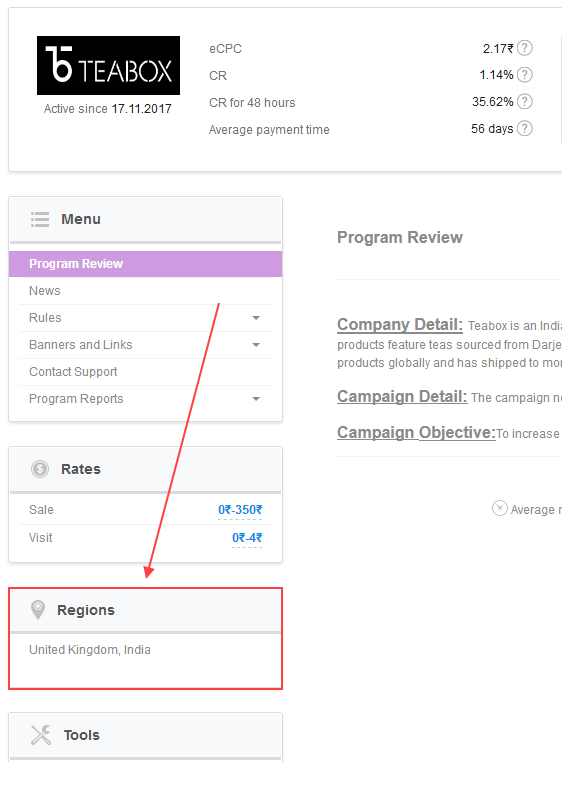
-
iframe
iframe is a technology that allows embedding the contents of third-party websites into a page.
For example, online stores often insert Google Maps on their contact pages to show the location of the store or delivery offices.
One of the most popular ways of using iframe is inserting a YouTube video on the page. This option is useful, for example, for bloggers who add trailers to their game reviews.
Admitad Partner Network uses iframe in coupons and promo codes. In the description of most coupons, publishers can find 2 links: one leads just to the page of a deal, and if you use the second link, the coupon in the iframe will be displayed in the page header.
If for some reason the advertiser is against using iframe on their website, they can ask the account manager to prohibit this type of coupon traffic. In this case, publishers will see only the first type of links. They will automatically replace all links with iframe that are already posted on the publishers' ad spaces.
Impression
An impression occurs every time a banner appears on a publisher's website.
How are impressions counted in Admitad Partner Network?
Affiliate programs provide publishers with banner codes containing affiliate links. Publishers place these codes on the pages of their websites. When a user comes to such page, the code is triggered and the Admitad Partner Network system registers code activation and saves the data.
Incentive traffic
Incentive traffic is the type of traffic when publishers promise users a non-monetary reward (bonuses, gifts) for performing certain actions.
Example: "500 bonuses for achieving X level!"
Integration
Integration is one of the stages required for a program launch in Admitad Partner Network. During integration, an advertiser sets up tracking of actions on their website and adjusts the mechanism of sending action data to the Admitad Partner Network's side. If integration is not completed, the program cannot be launched.
Read more about integration and its methods in this article.
-
Keywords
Keywords are words or phrases that describe the topic of the website and are used by search engines when selecting search results.
On the search engine results page, the websites are ranked by relevance to the query. This relevance is determined, inter alia, by matching keywords and the search query. Thus, if you determine what search queries are the most popular among your potential customers and add them as keywords to the website, it will rank higher on the SERP, which in turn will attract more visitors. The main difficulty is to understand what exactly the target users type in the search string and how to paste it inherently in the content of the site. The selection and placement of keywords on the site are one of the main areas of work of specialists in search engine optimization (SEO).
With the same goals, keywords are used in search ads, so the search engines can define what requests the ad is relevant to.
A special type of keywords is negative keywords. If a search query contains negative keywords, the ad will not be displayed in the search results. Negative keywords are added to prevent the ad from targeting a non-target audience, otherwise, its clicks will lower the CTR and lead to additional losses.
Most often advertisers add such lists to protect themselves from brand bidding or exclude the search queries they use themselves.
Be sure to add these negative keywords provided by the advertiser when setting up contextual advertising. Otherwise, it will be considered a violation of the rules, and actions containing negative keywords will be declined.
The list of negative keywords may be found in:
- The program description on the program page
- The program rules
- For some programs, the table that is downloaded when exporting affiliate programs from the catalog or My programs section (the negative keywords column)
-
Landing page
A landing page is a page that a user arrives at after clicking on a banner, a search ad, a link in a social network, or any other advertisement in other traffic sources. Such pages usually have a simple design, a short attractive description of a product or service, and a call-to-action button ("Send request", "Download", "Buy", "Learn more," etc.). The general goal of a landing page is to make a visitor perform an action.
Last Paid Click / Last Cookie Wins
Last Paid Click or Last Cookie Wins is an attribution model, according to which the action is attributed to the paid channel, whose link was the last one the user clicked before the action was performed.
All affiliate programs in Admitad Partner Network use exactly the Last Paid Click Model.
Latest action
Date and time when the latest target action was performed within the program (among the traffic led by all publishers connected to the program).
The indicator is shown on the program page and updated in real-time.
Lead
The term "lead" is used in two meanings: a lead as an interested user, a potential client and a lead as a kind of target action.
Admitad Partner Network uses the term "lead" in the second meaning.
Depending on an advertiser's business the following actions can be considered as a lead: registration in an online game or on a site, filled application for a loan, app download, booking, etc.
-
Moderation
Moderation is the process of approving a publisher for a program. An advertiser reviews the publisher's ad space and traffic sources. If they comply with the program rules, the advertiser approves an application and connects the ad space to the program. Otherwise, the application is declined (see more on why an ad space might be rejected).
The moderation time depends on the moderation type set for the program. It can be either automatic or manual. Learn more about this in the article "How long does moderation take? When will advertiser connect my ad space to their program?".
-
Native advertising
Native advertising is a kind of online advertising, that looks like the usual content of the website.
Native advertising is unobtrusive, that is why it is more favorably accepted by users and therefore is more effective than traditional advertising. In addition, native advertising cannot be blocked by extensions such as AdBlock.
Examples of native advertising: promoted videos in social networks or articles on sites (example).
Negative keywords
Negative keywords are used when setting up search ads, so that they are not shown for any search containing these keywords. This allows publishers to address the ad only to the target audience, which in turn reduces the costs of the webmaster to pay for non-targeted clicks and increases the CTR of the ad.
Most often advertisers add such lists to protect themselves from brand bidding or exclude the search queries they use themselves.
Be sure to add these negative keywords provided by the advertiser when setting up contextual advertising. Otherwise, it will be considered a violation of the rules, and actions containing negative keywords will be declined.
The list of negative keywords may be found in:
- The program description on the program page
- The program rules
- For some programs, the table that is downloaded when exporting affiliate programs from the catalog or My programs section (the negative keywords column)
-
Organic search results
Organic search results are a part of the search engine results page that are selected because of their relevance to a user's search query, and not because the advertisers paid to show them. Thus, organic search results are the opposite of contextual advertising.
Although some users consider organic search results to be more useful and objective because they are free, they can also be affected by investing resources in search engine optimization (SEO) and improving the site ranking in search engine results pages. -
Creator programs (Admitad Store catalog)
Type of affiliate programs in which actions are tracked via promo codes. Such tracking works even if a user has the cookies disabled or they use privacy tools. It means, target actions won't be lost. These programs are good for content creators who post their content on third-party resources (social media, blogs, etc.). The full list of programs can be found in Admitad Store catalog.
-
Creator programs (Admitad Store catalog)
Type of affiliate programs in which actions are tracked via promo codes. Such tracking works even if a user has the cookies disabled or they use privacy tools. It means, target actions won't be lost. These programs are good for content creators who post their content on third-party resources (social media, blogs, etc.). The full list of programs can be found in Admitad Store catalog.
-
Creator programs (Admitad Store catalog)
Type of affiliate programs in which actions are tracked via promo codes. Such tracking works even if a user has the cookies disabled or they use privacy tools. It means, target actions won't be lost. These programs are good for content creators who post their content on third-party resources (social media, blogs, etc.). The full list of programs can be found in Admitad Store catalog.
-
Pop-under
Pop-under is an advertisement that appears in a new window behind the main page.
Pros and cons of pop-under are almost identical to the pros and cons of pop-up. The main difference is that a user sees pop-under after they have viewed and closed the main page, so pop-under causes less irritation than pop-up.
Pop-up
Pop-up is an advertisement that appears in a new window in front of the main page.
Pros:
- Attracts maximum attention;
- Unlike banners cannot be ignored.
Cons:
- Intrusiveness can cause negative associations both with the product advertised in the pop-up and with the page where it is placed;
- Pop-up abuse affects SEO badly;
- It can be blocked by special extensions like AdBlock.
Product feed
Product feed is an XML, Google Merchant or CSV file that contains structured data about products from the advertiser's catalog.
With a help of product feed, publishers can automatically update information about advertiser's products on their ad spaces.
Feeds make it easier to work with large and frequently updated catalogs, so they may come in handy for:
- product comparison websites;
- affiliate stores (www.pricegrabber.com);
- automatic mailings with descriptions and pictures of products;
- promo websites with product advertisements.
Working with feeds:
1. Advertiser creates a product feed containing descriptions for various products from their website catalog and uploads it to the Admitad system. Advertiser's guide on preparing product feeds
2. Publisher uses the advertiser's product feed to place up-to-date information about advertiser's products on their ad space. Publisher's guide on working with product feeds
Postback
Postback is a mechanism for transferring conversion data from an affiliate network server to a client's server. Using this mechanism publishers can analyze received data and optimize their work.
Admitad Partner Network created a tool for the publishers based on this mechanism called Postback URL. With its help publishers can generate their own Postback URL and save it in the system. In this case, when the Admitad Partner Network server receives conversion data from the advertiser's server, it will automatically send the data to the publisher's server via the specified Postback URL.
PostClick cookie
PostClick cookie — the time after clickthrough on an affiliate link during which target actions performed by users are assigned to the publisher whose link was followed.
The indicator is shown on the program page.
The value is constant and set by the advertiser in the program settings.
Promo code programs (Admitad Store catalog)
Type of affiliate programs in which actions are tracked via promo codes. Such tracking works even if a user has the cookies disabled or they use privacy tools. It means, target actions won't be lost. These programs are good for content creators who post their content on third-party resources (social media, blogs, etc.). The full list of programs can be found in Admitad Store catalog.
Publisher
A publisher is an owner of an ad space (website, community in a social network, online app or game, etc.) where they place ad creatives to attract visitors to an advertiser's website. For every target action performed by an attracted visitor, the publisher gets a reward from the advertiser.
-
Rate
Rate is a correlation between a target action and a reward for it. A reward can be either a fixed sum or a percentage of an order amount.
You can see the rate in a program card in the Admitad Store catalog.
To do so, click on the commission value:
In the window that opens, you'll see target actions and the reward amount the advertiser pays for these actions:
You can also learn the rate on the program page:
Referral
A referral is a user who registered in an affiliate network after following a referrer's unique referral link (and for their registration this referrer gets a reward).
Referral link
A referral link is a unique link that every participant of a referral program receives to attract new users.
Referral program
A referral program is a program created for attracting new users to an affiliate network. Referral programs work as follows: after registration, a publisher gets a unique referral link that they place on their ad space or somewhere else. Users who followed this link and registered in the system, become their referrals for a certain period specified by the program. During this period the publisher gets a reward for every referral: it can be a fixed amount or a percent from a referral's earnings (depending on the terms of the referral program). Note that it is the affiliate network that pays a reward, so referrals do not lose anything.
For more information on our referral program follow this link.
Referrer
A referrer is a user who attracts referrals and gets a reward for them; a user who placed a referral link.
Retargeting
Retargeting is an advertising technique where online advertising is sent to users who have viewed the product or visited the advertiser's site but did not make a purchase. The main objectives of retargeting are to bring users interested in the product back to the website or to attract new users whose search queries indicate an interest in the product.
Technically, this is executed through ad networks or via advertising agencies that purchase impressions at various ad spaces. A special code is placed on the advertiser’s website that records a variable in the user's cookie if the user performs certain actions, such as registering or browsing products. This variable is the user's ID at other websites or it is recorded in a database of the platform providing retargeting services. When the user visits a website that collaborates with the platform, a banner code at this website reads the cookie and based on this identifier, selects and shows the user the corresponding banner ads.
Admitad Partner Network gives its advertisers a special tool called ReTag to make it easier to insert the code on their site. ReTag is a universal container that is installed once as a script on the required website pages, for example, on the pages of product categories or product cards. It takes only a few clicks to add the script of any retargeting affiliate to the container. The script is added by the affiliate with whom the advertiser agreed to cooperate, and there is no need to edit the website's HTML code. This approach greatly simplifies the code's installation on an e-store website. Otherwise, the process is usually very time-intensive for advertisers’ programmers and may even take as long as several months. And most importantly, there is no need to do this repeatedly for new affiliate scripts.
Reward
The reward is a remuneration that an advertiser pays to a publisher for leads and sales generation. The reward amount is determined by the program rate and is paid in the currency of the program.
-
Sale
Sale is a kind of target action; purchase of a product or a service by a user on an advertiser's website. Sale is counted as an action when a user gets to the "Thank you" page. If the order was paid and delivered, an advertiser confirms the action and pays a reward. If the order was canceled, unpaid, or returned, the advertiser declines this action, and a publisher gets no reward for it.
SEM
SEM (Search Engine Marketing) is a type of internet marketing aimed at improving website ranking in search engine results pages and attracting traffic from search engines.
The main SEM tools are SEO and contextual advertising.
SEO
SEO (Search Engine Optimization) is the optimization of a website in order to improve its ranking in search engine results pages. The higher the ranking is, the more traffic the website gets. Search engine traffic has high quality: if users search for any product or service, they are already interested in it and are ready to buy it.
You can improve your website ranking by
- using relevant keywords;
- generating unique content and regularly updating it;
- fixing errors like 404;
- crosslinking (pasting internal links);
- backlinking;
- submitting your website to search engines.
Session
Session or browser session is a time period of user activity on a website. The session starts when the user enters the website and ends at the moment the user closes the web page or browser.
In Admitad Partner Network, the term is most often applied to the AliExpress affiliate program, as its cookie lifetime is exactly 1 browser session.
Shaving
Shaving is the intentional discarding of actions by the advertiser.
SMM
SMM (Social Media Marketing) is a form of internet marketing aimed at promoting a brand, product, or service through social networks.
SMM includes:
- Building communities, groups, blogs, forums in social networks;
- Running advertising campaigns or promotions;
- Generating unique content that will be shared by followers;
- Communication with followers;
- Creating apps and games for social networks.
SOI
Single Opt-In or SOI in a broad sense is a signup method that does not require confirmation of the email address. Users just fill out the signup form on the website, enter their email address and click submit, and their subscription is immediately confirmed.
In Admitad Partner Network, there is the term "SOI Registration". It is a type of action used by gaming affiliate programs. SOI Registration implies signup in an online game that does not need to be confirmed by email, phone, or other means. In the Admitad Store catalog it is often called just Registration.
A more complicated type of subscription or registration is a DOI subscription/registration.
Subscription fee
A subscription fee is a monthly fee that advertisers pay Admitad Partner Network for using its services. The amount of the subscription fee is stated in the advertiser's agreement.
-
- Targeting
- Target audience
- Targeted ads
- Teaser ads
- Thank you page
- Ticket
- Toolbar
- Tracking code
- Tracking request
- Traffic
- Traffic source
Targeting
Targeting is an advertising technique that makes sure ads are displayed only to users that meet specified criteria. These users are called the target audience. The criteria may include age, gender, geographical location (geotargeting), hobbies and interests, etc.
Using targeting, the advertiser can significantly reduce its advertising costs by working only with users who are potentially interested in its product.
Target audience
Target audience means potential consumers of a product or a service at whom advertising campaigns are aimed.
The target audience can be determined by the following characteristics:
- location;
- demographics: gender, age, nationality, marital status, education, income, occupation;
- psychographic information: interests, opinions, lifestyle.
For example, the target audience of healthy meal delivery services is young working professionals and young families with working parents from big cities.
When working with an affiliate program, you need to know its target audience, especially if you have your own ad space: a website, a group in social networks, a channel in a messenger, or on YouTube. In this case, the target audiences of the program and your ad space should have at least some common features, so that your visitors could get interested in the advertiser's product and buy it. For example, advertising building materials on a women's forum is unlikely to give any result.
If you are involved in traffic arbitrage, you are not limited by specific ad spaces and can join any program, but in this case, the understanding of the target audience is necessary for creating an effective ad, too. By specifying relevant keywords and negative keywords in the settings and adjusting accurate settings for the target audience, you will ensure that your ad does not compete with hundreds of others, but is shown only to a small but motivated range of users who are ready to buy the advertiser's product or service. Then the CTR and CR of the ad will be higher, and you will not have to spend the budget on paying for clicks of uninterested users.
Before launching a program, we ask advertisers to add information about their target audience to facilitate the work of publishers. You can find this information in the program description.
Targeted ads
Targeted advertising is a type of social media advertising that is shown to a target audience meeting specific criteria (age, gender, location, interests, etc.).
For instance, it is safe to show ads of delivery of cheap cosmetics in Paris to ladies aged 17-25 living in Paris.
What target audience parameters are available depends on what user data a network registers and collects. Most often, these are the following parameter groups:
- Demographic: gender, age, education, income, occupation.
- Geographic: residence, registration, or visit location. Some networks allow showing ads to users within a certain radius around a selected location.
- Technical: device type (e.g., phone or PC model).
- Psychographic: values, relationship status, opinions, lifestyle, and interests.
- Behavioral: recent actions in the browser history (order history, webpage history, etc.).
- Time: hours and days when they can use the service or buy the product.
What formats of targeted ads are available depends on the network where you launch your campaign. For instance, Instagram allows setting up targeted ads in Stories or in the feed (as ordinary posts).
Targeted ads in the Instagram feed
Teaser ads
Teaser advertising is a form of advertising where an intriguing, provocative, and often false message, or an image that provokes curiosity, is used in the advertising content.
The ad may be about an unrelated subject, such as "Famous actress diagnosed with a terrible disease". In this case, clicking on it may lead to another teaser ad website, while the landing of the advertised product will open in a pop-up window in the browser.
Direct teaser advertising of the product can be used as well. In this case, the ad will often provide information about the product, although the actual product will not be obvious yet.
As a rule, teaser advertisements tend to have higher CTR than conventional banners − something that users have already gotten bored with.
Thank you page
A thank you page is a web page where a user is redirected after placing an order, filling an application, etc. On this page, an advertiser sets the tracking code to track actions. Accordingly, if a user does not reach this page, the code is not triggered and the information about the action cannot be fixed in the statistics.
Thank you page of Booking.com
Ticket
A ticket is a form of communication between publishers and Admitad Partner Network. Through the ticket, you can contact the technical support or your manager to clarify some moments or ask for help. In turn, Admitad Partner Network specialists can create a ticket to ask questions about traffic and ad space. Sometimes even advertisers are involved: through the program manager they can offer you individual terms.
To create a ticket, click on the Support link in the upper right corner of any page of your account.
When the Admitad Partner Network specialist answers your ticket or creates a new one, you will see a notification right to the Support icon.
Toolbar
The toolbar is a dashboard element embedded into a browser that contains additional controls or information for the user.
A toolbar is typically part of a browser extension, computer program, or browser and so it gets installed along with them.
In affiliate marketing, a toolbar can be a traffic type which publishers can use to drive customers to advertisers' sites.
For example, some publishers supply their extensions with toolbars that let people know about discounts or special offers and contain affiliate links.
Tracking code
A tracking code is a JavaScript code for tracking actions on an advertiser's website.
The advertiser sets this code on the thank you page of their website before launching the affiliate program. Every time when visitors of the website make a purchase, fill out an application and get to the thank you page, the system checks if their browsers have admitad_uid, which is recorded there when a user clicks the affiliate link. If admitad_uid is found, the tracking code is triggered, and information on this action, including the order number, order amount, tariff code, and the uid itself, is sent to the Admitad Partner Network side. Based on this information, the Admitad Partner Network system attributes the action to a certain publisher and calculates the reward for it.
Tracking request
A tracking request is a request from an advertiser to Admitad Partner Network that contains information about a completed action: admitad_uid, action ID, affiliate program code, and other data (e.g. order amount or action time).
Traffic
The term "traffic" in affiliate marketing means users that followed an affiliate link and landed on an advertiser's website.
Traffic volume is the number of unique users that landed on an advertiser's website for a certain period of time.
To learn about buying and selling traffic, see Arbitrage.
Traffic source
A traffic source is a space from which a user came to the advertiser's website. Websites, communities in social networks, YouTube channels, search ads can all be considered as traffic sources. For more information on the traffic sources follow this link.
Each affiliate program in Admitad Partner Network has its own list of allowed traffic sources with which it is ready to work. Accordingly, ad spaces of publishers who want to join the program must be on this list, otherwise, applications will be rejected.
Example
Two publishers applied for joining the iHerb program: one of them owns a cashback service, the second one creates search ads. Cashbacks are allowed, so the application of the first publisher will be approved. However, the second publisher will not be allowed to work with the program, because such a traffic source as "SEM" is prohibited by the program rules.
Sometimes publishers apply with allowed ad spaces, but after an advertiser approves them, start generating traffic from forbidden sources. This is a rules violation, and such actions will be rejected when reconciling. In case of repeated violations, the publisher will be disconnected from the program.The list of allowed traffic sources can be found in the rules on the program page.
-
Unique visitor
A unique visitor is a new user who came to the website for the first time and whose IP address, browser, operating system, cookie do not match the data of previous visitors. Otherwise, the user is not considered unique, and the visit is fixed in the statistics as a website impression.
A unique visitor is a unit of traffic volume. The traffic volume is the number of unique visitors of a website for a certain time period. Traffic volume is typically measured over a day or a month. The larger the traffic volume is, the more effective and popular the website is considered to be.
To estimate traffic volume, various web analytics services are used. The most famous of them is Google Analytics.
Remember that the number of unique visitors differs from the number of real users who visited the website. One user may be fixed in the statistics as several unique visitors, if he first visits the website from the PC, then from the phone, then clears cookies or installs a new browser. But as it is not possible to calculate the exact number of users, this indicator is considered the most adequate for assessing traffic volume.
The traffic volume is one of the main criteria when selecting partners for cooperation. For example, Admitad Partner Network has specific requirements for the traffic volume of the advertisers' who want to launch an affiliate program in our network. If the traffic volume is lower than required, the program will most likely not be popular among publishers, so such applications are usually rejected.
The number of unique visitors determines the effectiveness of publishers' ad spaces, too. That is easily explained: the more visitors come to the website, the more actions they perform, the higher profit an advertiser gets.
This applies not only to cooperation in the affiliate networks. If an advertiser wants to have their product or service promoted (usually in the form of reviews) on a blog, when choosing a suitable blog, they will also primarily focus on traffic volume, to be sure that the ads will be seen by as many people as possible. And, all things being equal, a blogger with a bigger number of visitors will most likely be chosen. In turn, owners of popular websites can set higher prices for advertising, thereby increasing their income.
-
Verification
Verification is the process of assigning final statuses to processed actions. There are two types of verification: automatic and manual.
At the automatic verification, Admitad Partner Network refers to the advertiser's system, collects statuses of processed actions, and uploads them to the reports. Normally, automatic verification is carried out daily.
At the manual verification, the advertiser assigns statuses manually. The manual verification is periodic, typically, it is carried out once a month.
During the verification, processed actions are assigned the Confirmed or Declined statuses in the reports.
On the next day after the verification, the reward for the confirmed actions in the Balance Details section will be transferred from On Hold to:
- Ready for withdrawal, if the program balance is sufficient enough to make a payment. After that, you'll be able to withdraw your earnings.
- Awaiting advertiser payment, if the program balance is insufficient to pay the reward. Funds will be available for withdrawal right after the advertiser replenishes the program balance.
Declined actions are not rewarded. In this case, the reward will disappear from the Balance Details section.
-
Widget
A widget is a small application that is placed on a page so that users can perform a certain function or access a service. For example, using widgets you can:
- allow customers to sign in through social networks
- grow your social media audience by suggesting to follow you on social networks
- collect customer contacts for email marketing
- consult customers and handle their problems
- allow customers to sign in through social networks
Admitad Partner Network glossary
Is this article helpful?





